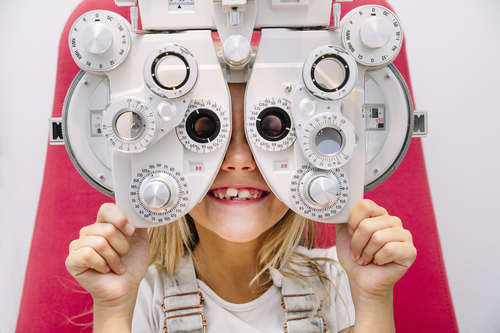Discovering the current Technical Advancements in Optometry and What They Mean for Optometrists
From the precision of Optical Comprehensibility Tomography to the nuanced insights supplied by AI-driven diagnostic devices, these advancements are setting new standards in individual analysis and therapy. As these advancements penetrate the technique, optometrists are encountered with the difficulty of accepting these devices to boost client outcomes.
Developments in Diagnostic Devices
Progressing the area of optometry, advancements in analysis tools have transformed the means eye care professionals assess and identify visual problems and eye conditions. The past decade has observed significant technological developments, making it possible for even more extensive and exact evaluations.
An additional trick development is the intro of sophisticated corneal topography systems, which map the surface curvature of the cornea with precision. These devices are particularly beneficial for fitting contact lenses and detecting corneal conditions. Furthermore, digital retinal imaging has transformed traditional ophthalmoscopy, providing detailed, scenic sights of the retina that promote comprehensive aesthetic exams.
The development of wavefront aberrometry has actually likewise been essential, allowing the analysis of refractive errors with unmatched precision (Eye Doctor). This technology aids in tailoring rehabilitative lenses and enhancing surgical results for refractive surgical treatments. Jointly, these analysis improvements empower optometrists to supply premium patient care, guaranteeing very early treatment and customized treatment strategies, ultimately improving aesthetic wellness outcomes
AI in Individual Administration
Building on the foundation of advanced analysis tools, the unification of fabricated intelligence (AI) in client administration stands for a transformative leap for optometry. AI systems are increasingly employed to improve effectiveness, precision, and personalization in patient treatment.
Additionally, AI-driven systems promote structured person communications and administrative processes. Automated scheduling, virtual appointments, and customized follow-up plans not just improve individual complete satisfaction however also optimize time administration for practitioners. These systems can triage patients based on the seriousness of their conditions, making sure that those in essential need obtain prompt interest.
Moreover, AI boosts decision-making by supplying optometrists with evidence-based suggestions and therapy pathways. By integrating information from digital health records, AI tools offer insights that educate professional choices, reducing the threat of mistakes and boosting person outcomes. As AI remains to develop, its role in individual administration will likely broaden, improving the landscape of optometric care.
Developments in Retinal Imaging
In the world of optometry, retinal imaging has experienced exceptional technological developments that are boosting diagnostic capacities and client treatment. Developments such as Optical Coherence Tomography (OCT) and fundus digital photography have reinvented how optometrists imagine and assess the retina.
Improved imaging modalities like OCT angiography are further refining analysis accuracy. Eye Doctor Optometrist. Such advancements help with the identification of min retinal modifications that could represent illness development.
Additionally, advancements in synthetic intelligence are augmenting retinal imaging by enabling automatic analysis of large datasets. These systems aid optometrists in identifying patterns a sign of pathology, thereby enhancing diagnostic accuracy and performance. Jointly, these innovations are transforming retinal imaging into a foundation of modern eye care, improving results and increasing therapeutic opportunities.
Teleoptometry's Expanding Duty
Teleoptometry is significantly ending up being a crucial part of eye treatment, driven by advancements in digital communication and diagnostic tools. As optometry welcomes electronic transformation, teleoptometry helps with remote consultations, allowing eye doctors to expand their services beyond traditional borders. This is specifically advantageous in underserved and country areas where access to specialized eye care is often minimal. By leveraging high-resolution video conferencing and progressed retinal imaging, eye doctors can conduct extensive eye tests from afar, ensuring timely diagnosis and treatment.
The assimilation of man-made knowledge (AI) additional enhances teleoptometry, enabling the evaluation of visual data and assisting in the detection of ocular conditions such as glaucoma and diabetic person retinopathy. AI-powered algorithms can rapidly translate complicated imaging data, supplying optometrists with valuable insights that strengthen professional decision-making.
Moreover, teleoptometry supports continuity of care with seamless assimilation with electronic health and wellness documents (EHRs), enabling optometrists to preserve extensive client histories. When seeking advice from with check out this site various practitioners., this guarantees that people obtain regular and individualized care also.
Regardless of these advantages, challenges stay, including making sure information security and handling patient assumptions. However, teleoptometry represents a significant stride in the direction of more easily accessible, efficient, and patient-centered eye treatment. As innovation develops, its function is positioned to increase further.

Future Trends in Eye Care
A myriad of cutting-edge patterns is readied to improve the future of eye care, driven by technological developments and the developing requirements of patients. One substantial pattern is the assimilation of expert system (AI) in diagnostics, which promises to boost the precision and effectiveness of eye evaluations. AI algorithms can evaluate vast quantities of information from retinal pictures, possibly discovering conditions like diabetic person retinopathy and glaucoma earlier than traditional approaches.
In addition, tailored medicine is getting traction in optometry, with genetic screening notifying tailored therapy try this website plans. This strategy aims to enhance individual end results by customizing interventions to specific hereditary profiles. Wearable technology, such as smart call lenses, is likewise imminent, supplying real-time monitoring of intraocular pressure or sugar degrees, hence providing continual understandings right into ocular and systemic health.
The adoption of augmented fact (AR) and digital fact (VIRTUAL REALITY) in training and person education is an additional emerging pattern. These technologies supply immersive experiences that can enhance understanding and abilities both for individuals and eye doctors. As Extra resources these trends progress, eye doctors need to remain abreast of technical developments to provide advanced treatment, guaranteeing better individual outcomes and satisfaction in the dynamic landscape of eye treatment.
Final Thought

Jointly, these analysis developments empower eye doctors to provide exceptional patient care, making sure early treatment and customized treatment approaches, eventually improving visual wellness results.

As these technologies continue to progress, optometrists have to adapt and incorporate them into practice, inevitably maximizing process efficiency and boosting the standard of eye care supplied to people.